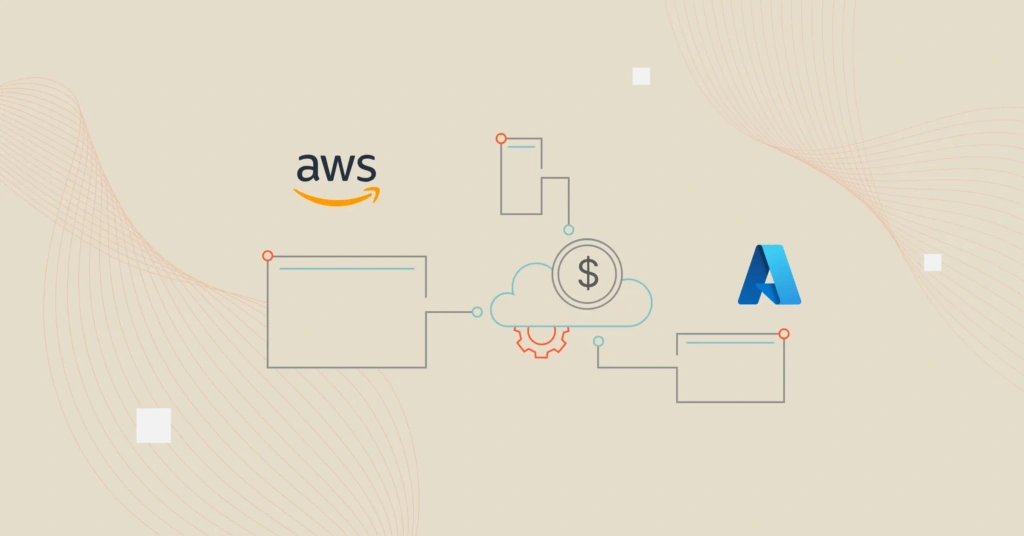Cloud cost optimization refers to reducing overall cloud spending by identifying mismanaged resources, eliminating waste, reserving capacity for higher discounts, and right-sizing computing services to scale.
In the modern business environment, where agility and efficiency are paramount, mastering cloud cost optimization reduces expenses and strategically allocates resources to drive innovation and growth.
This article delves into the nuances of cost optimization across two major cloud platforms: Amazon Web Services (AWS) and Microsoft Azure. While both platforms offer robust solutions, they present unique approaches and tools for cost management.
Understanding these differences, along with their similarities, is crucial for businesses operating in a multi-cloud environment.
Additionally, we’ll explore how CloudZero, a cloud-agnostic platform, provides a unified view of costs across AWS and Azure, offering a ‘single pane of glass’ for organizations to manage their multi-cloud operations effectively.
Cost Optimization On AWS
Within AWS, effective cost management and optimization are central to maximizing cloud investment. AWS offers a variety of tools and strategies to assist businesses in this endeavor:
- AWS Cost Explorer – A pivotal tool for visualizing, understanding, and managing AWS spending. It provides:
- Detailed reports breaking down costs by service and time.
- Analysis of usage patterns for insightful decision-making.
- Reserved Instances (RIs) – A strategic approach for cost savings involving:
- Reserved cloud capacity for one or three-year periods.
- Offering substantial savings over on-demand pricing for predictable, consistent workloads.
- Auto Scaling – Dynamically adjusts resources in response to usage patterns, optimizing costs while maintaining performance.
These tools and strategies illustrate the comprehensive nature of AWS’s approach to cost optimization.
For example, a global enterprise can utilize Auto Scaling with Cost Explorer to dynamically manage resources, resulting in significant cost reductions without compromising on service delivery. However, it’s important to understand that while AWS offers various tools, their recommendations should be taken with a grain of salt and validated before implementation.
Cost Optimization On Azure
Shifting focus to Azure, this platform also presents its unique features and tools for cost management and optimization, which is integral in today’s cloud-centric business landscape. Azure’s commitment to helping users control and optimize cloud spend is evident in its tailored offerings:
- Azure Cost Management – This service is Azure’s answer to cloud financial management, providing tools for:
- Monitoring and controlling Azure spending.
- Generating comprehensive cost reports and analytics.
- Azure Reserved VM Instances – Similar to AWS’s Reserved Instances, Azure offers:
- Significant cost savings over pay-as-you-go pricing models for virtual machines.
- Best suited for predictable, steady-state workloads.
Azure’s approach to cost optimization is exemplified through various success stories. For instance, a company could leverage Azure Cost Management and Reserved VM Instances to dramatically lower operational costs.
By reserving instances for their consistent workloads and using Azure Cost Management for real-time monitoring and analysis, they achieve optimized spending without sacrificing performance.
However, just like with AWS, it’s important to understand the limitations of these native tools.
Blindly implementing recommendations by these tools without fully understanding the implications can be a recipe for disaster. Ensure that you thoroughly analyze the impact on your application before proceeding.
Comparing And Contrasting AWS And Azure In Cost Optimization
AWS and Azure present unique strengths and approaches while sharing some fundamental similarities. To understand their impact on cost management, let’s examine these aspects in detail:
Similarities in cost optimization between AWS and Azure
- Shared tools and strategies
- Both platforms offer robust tools for monitoring and controlling cloud spending, such as usage reports and budget allocations, which are essential for efficient cloud cost management.
- Common challenges they address include managing underutilized resources and navigating complex pricing structures.
- Common goals in cost management
- AWS and Azure are designed to reduce expenses while enhancing efficiency, identifying mismanaged resources, and optimizing resource allocation.
Differences in Cost Optimization Between AWS and Azure
- Unique tools and features
- AWS is renowned for its AWS Cost Explorer and Auto Scaling, which are highly effective for dynamic resource adjustment and in-depth cost analysis.
- Azure distinguishes itself with Azure Cost Management and a focus on Reserved VM Instances, offering integrated solutions and specialized options for virtual machines.
- Pricing models and use-case scenarios
- AWS’s flexible pricing is advantageous for businesses with variable workloads, offering various purchasing options and services.
- Azure’s model caters to enterprises integrated with the Microsoft ecosystem, potentially offering lower costs for specific services and better overall integration.
These distinctions and parallels underscore the importance of choosing the right platform based on specific business requirements. Whether AWS’s flexibility or Azure’s integrated management solutions and compatibility with Microsoft products, each platform offers tailored advantages for different organizational needs.
CloudZero: A Unified Solution for Multi-Cloud Cost Optimization
When cloud computing first emerged, it made sense for early adopters to become entrenched within one particular cloud ecosystem. However, as technologies have advanced, more businesses have opted for a multi-cloud approach.
What happens to organizations that want to leverage the features of different platforms but still want to maintain a simplified way of viewing their costs and optimization options?
This is where CloudZero shines. Designed to be cloud-agnostic, the CloudZero platform provides a comprehensive and cohesive view of costs across AWS and Azure (and many other cloud and software platforms).
This approach addresses the challenge of managing expenses in a multi-cloud setting, where each platform has its own tools and pricing models.
Features of CloudZero that enable cross-platform management
- Unified cost management
- CloudZero consolidates cost data from both AWS and Azure, presenting it in a user-friendly dashboard.
- Real-time analytics
- Offers real-time insights into spending, allowing businesses to make prompt and informed decisions about their cloud resources.
Benefits of Using CloudZero for Organizations Leveraging AWS and Azure
- Single pane of glass for monitoring and managing costs
- CloudZero provides a centralized platform for viewing and analyzing costs across AWS and Azure, simplifying the complexity associated with multi-cloud cost management.
- Cloud agnostic approach to cost optimization
- Ensures that business are not locked into a single provider’s tools and can make unbiased decisions based on comprehensive data from both AWS and Azure.
Customer stories and testimonials highlight the effectiveness of CloudZero in diverse scenarios. Many organizations have harnessed the power provided by the CloudZero platform to significantly cut their costs and re-allocate resources back into the investment, allowing for unprecedented growth and innovation.
The differences between the two major providers, Azure and AWS, will most likely continue to get smaller, making platforms like CloudZero integral for bridging cost optimization between the two.
Don’t get left behind;  today and see how CloudZero can help your business grow!
today and see how CloudZero can help your business grow!








